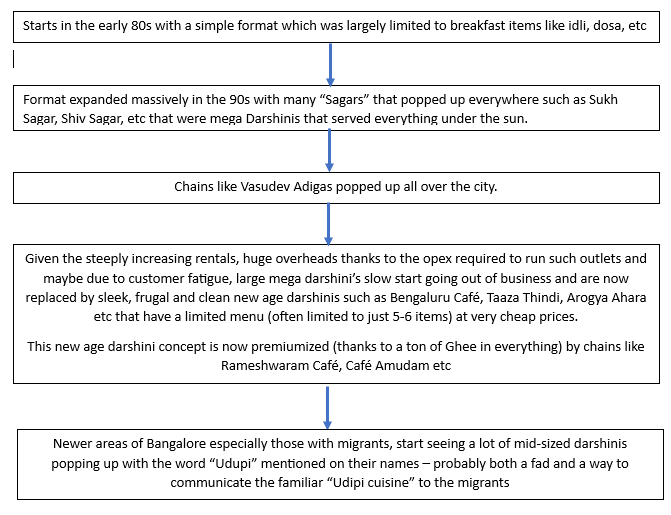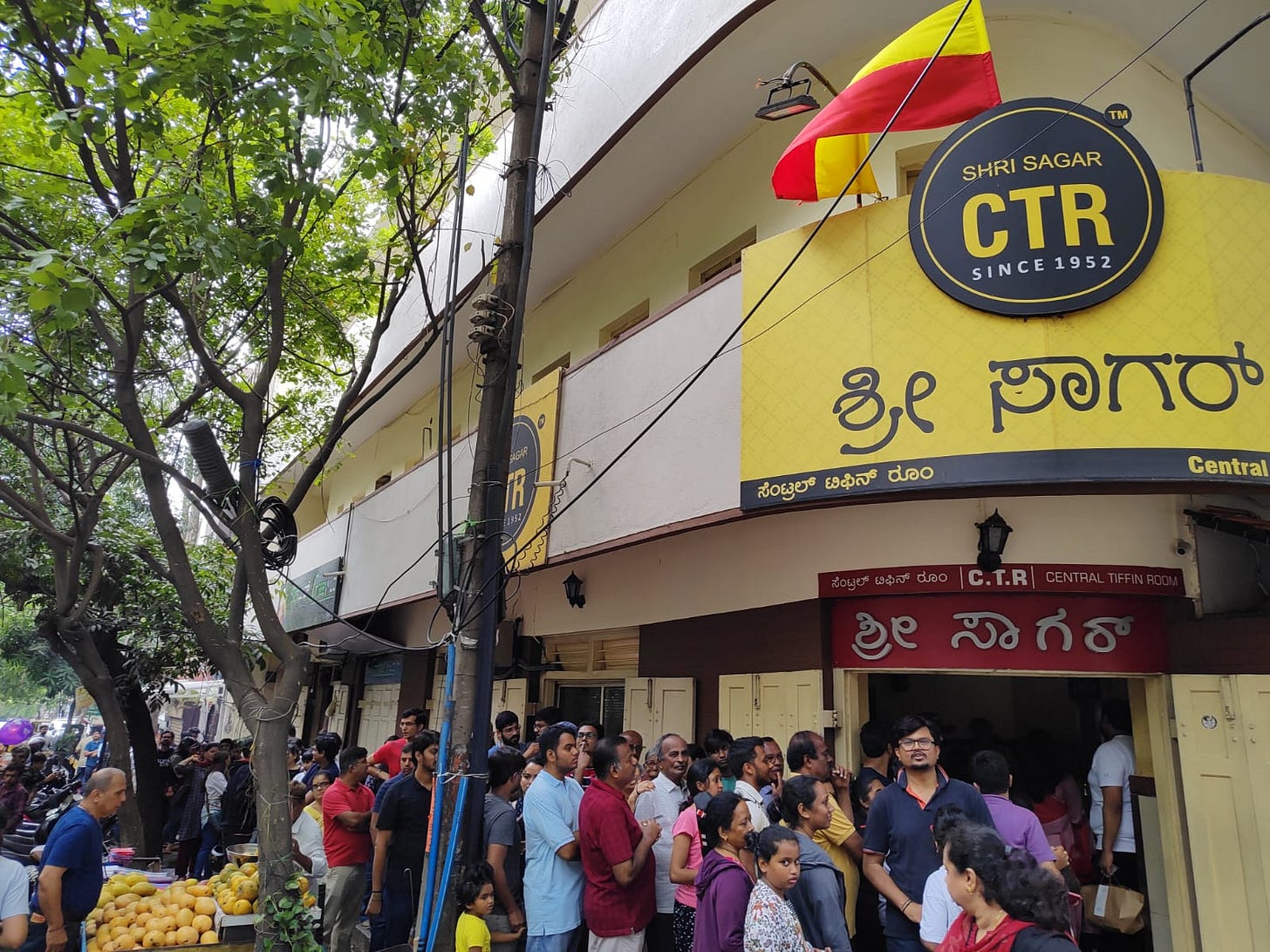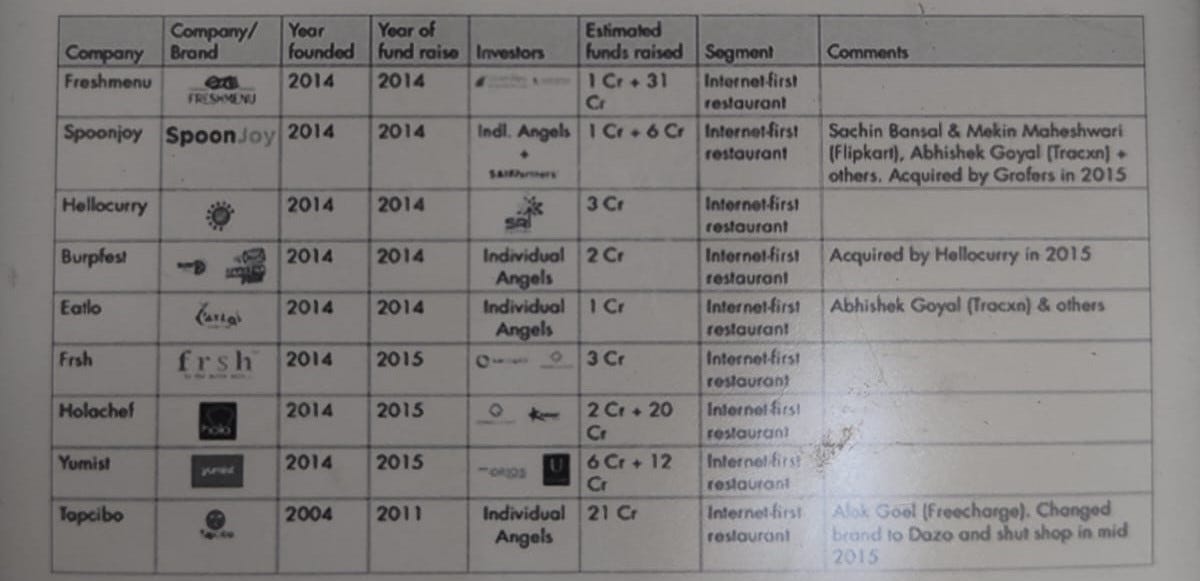Bangalore Blog 3 - Darshinis, Rameshwaram Cafes, CTR and Adigas - stories and observations from the business of restaurants
Darshinis are central to the food culture in Bangalore - a largely quick service restaurant (QSR) format that serves everything from South Indian breakfast items to a thali and often times some “mega darshinis” also expand into chaats, juices, North Indian and Indo-Chinese food. I believe this format is quite unique to the city even now despite all the evolution it has undergone over the years.
While “tiffin rooms” were always in place in the city since the time of the British occupation (example - Mavalli Tiffin Room aka MTR or Central Tiffin Room aka CTR or Udupi Shri Krishna Bhavan), this format apparently started at Upahara Darshini in Jayanagar, Bangalore in the early 80s when R Prabhakaran wanted to replicate the QSR format in the city after learning about this format in his travels abroad. Now, Bangalore is said to have more than 5000 darshinis with the Nayaks, Shettys and Kamaths from the Mangalore-Udupi region dominating the trade in this space.
Darshinis are places where the group of older uncles come for their morning/evening cup of coffee and chat, the students come for their lunch meals, the busy working class come for their afternoon thali or the family come for an evening out. They truly do not differentiate by caste, appearance and income groups.
Quick Story: Rava Idli was actually invented by MTR. During World War II, when rice, which is the staple item used in idli, was in short supply, they experimented in making idli using semolina and created the rava idli.
One of these mega darshini chains that could be all over the city was Vasudev Adigas which probably had at least 3-4 dozen outlets at its peak. It was acquired from Mr. Adiga by a PE Fund called New Silk Road Ventures for a fairly steep fee.
Fast forward to 2023, I hardly see any Vasudev Adigas anywhere in the places where there were once located. At the same time, I found out about a new brand called “Paakshala” that was mushrooming across the city and was promoted by none other than Vasudev Adiga himself.
Quick Story: I once saw this beautiful speech by Harsha Bhogle at IIM-A where he talked about excellence amongst other things. If you skip to about the 33 minute mark in that video, he talks about finding it difficult to find role models in the world of broadcasting and talks about how he had deep admiration for the focus and accuracy of the cameraman who had to keep going ball after ball for hours together and not lose sight of the ball.
Similarly, I too believe that finding role models doesn’t need to be limited to the hi-flying corporate celebs. I love going to Brahmin’s Coffee Bar for long. While the food is great there, I think the filter coffee is also probably amongst the best on planet Earth. I massively admire the gentleman who makes the filter coffee there (image below). He does that same routine, with some style, hour after hour and year after year with that same consistency as ever and seems to be laser focused when he does it. What I may see as boring and mundane is something that he does with fervour. How can’t you admire such a person and find inspiration?
Evolution of Darshinis:
This flowchart tries providing gist of how darshinis have evolved.
The central point of the flowchart above is that in this world of darshinis, things also don’t last forever. The success of yesterday can get wiped out in no time. I believe that these mega darshinis suffered from its own expansive menu, large real estate requirement, huge overheads and manpower requirements and gave way to sleeker business models that were more “new age” as seen in darshinis like Taaza Thindi, Asha Tiffin, Bengaluru Cafe, Arogya Ahara and to an extent even Rameshwaram Cafe. These promised good food (with a high degree of predictability) with a limited menu, open kitchens and a big emphasis on hygiene and cleanliness.
Paakshala is nothing but a revamp of Vasudev Adigas that had a sleeker menu and branding and some repackaged dishes to suit the new palate.
The business of restaurants
I gave this example of darshinis to show what are some of the key dynamics that matter in the world of restaurants.
Many people get fascinated with a concept of running a restaurant for various reasons such as:
I don’t want to work in a 9 to 6 job
I want to be an entrepreneur
I cant believe how many people go mad at Rameshwaram Cafe and Toit and I want to make that kind of money
Quick Story: Lakshmi Nataraj Refreshments aka Pandus in an institution in itself and is located in the crowded and narrow by lanes of Naghrathpet. I remember eating there in a street stall a couple of times in my school days and it was the first time I had a “bath” dosa (i.e. - dosa with pulao in it). Fast forward to 2023, he has a proper restaurant in that area and owns half a dozen of the expensive little buildings nearby.
I love food and I love people and I love the energy in this space
However, as those of you who have visited the area near Empire restaurant in Koramangala 6th block would agree with, the restaurant business has a brutal failure rate and some say it stands at over 80%. I seem to notice a new restaurant/eatery every other week in that area!
Apart from my general observations and readings, I read a book called “Start Up Your Restaurant: The Definitive Guide for Anyone Who Dreams of Running Their Own Restaurant” by food journalist Priya Bala and Jayanth Narayanan who founded the Mani’s Dum Biriyani chain of restaurants. Some of the key pointers from the book on running a restaurant are:
For a typical restaurant, you must maintain a gross margin of at least 60%. This can go down to 30-40% if you run small stall that has minimal overheads
You will typically spend a third of your revenue in overheads alone
Location is key to everything - you have to choose a place that is ideally on the ground floor, is easily visible and has the right facilities available
In terms of funding, you are generally on your own. Banks hesitate in lending to restaurants and VCs/PEs wont bother with you unless your format is standardized and scalable.
Quick story: When I was in Kotak Bank, I met the owner of the popular brewery Arbor Brewing Company. He had a line of credit from a PSU Bank and shrugged off private sector banks saying that they look for excess collateral especially given that his business was that of a restaurant. I then asked him what his plans for expansion were. He said that they have already started a bottling facility and a cafe in Goa and are looking to expand in places like Mauritius or Singapore next. I asked him “Why not Mumbai or Delhi?” to which he said “Mumbai is too expensive and people in Delhi inevitably end up drinking whisky after a mug of beer”. Lol.
You will require a lot of paperwork and permissions from the trade licence form corporation, FSSAI health certificate, safety permits, professional tax, labour license, alcohol license etc.
Quick Story: While this book doesn’t get into this grey area but it is well known that this business also deals with a lot of cops and bureaucracy. My friend’s cousin runs a popular Hawaiin style pub in Indirangar. Now, new years eve is a big event for everyone in this space since you will make at least 5x more money than you would on a typical day.
One day a corporator from the municipality comes in and threatens to shut the place down (due to xyz violations). The owner tries to defend his ground but with facing a large loss at new years eve and an indifferent corporator, he succumbs and meets the corporator in a dark graveyard at CMH road at the last moment and does what it takes to let him run his business (pays a bribe!)
Number of people required? 30-50 for fine dining or slightly high end restaurants, 8-14 for cafes, anything from 15-50 for chains.
The Menu can't be huge unless you can afford it and can't be needlessly fancy or else overheads, wastage and preparation time will spike and consistency may take a hit
Marketing can be done by:
The power of the location and the elements of vibility you put forth
Word of mouth
Ratings in Zomato, Google etc which I swear to god are so often rigged - especially those reviews that are put in by someone with 1-2 reviews only OR those reviews where someone is forced to write at gunpoint “The food and service was great. A special thank you to Sachin who took good care of us!”
Influencers and social media (Rameshwaram Cafe did a social media blitzkrieg in its initial days)
I think the restaurant business is brutally difficult to crack unless one has a great appetite (pun?) and upfront capital. Some random thoughts that have come to me over sometime:
If you think your house rental is insane, the rentals in this space is just mind boggling - Koramangala for example has a rental of anything from 700 to 1500 per sq ft per month!
Customer fatigue is real, choices are near infinite loyalty is very hard to build (unless its me and Toit - I got alarmed at the number of times I’ve been to Toit when I checked that feature in Google Maps). Brands come up and die out in no time at all. Look at the images from the aforementioned book of brands that were funded in the early to mid 2010s.
How many of these brands do you think exist today let alone thriving today? Very very few.
In fact, even the most popular QSR chain in the world Subway, which promised fresh and healthy food, is now sold after years of decline - even that has “conditions apply” tagged to it.
Whenever I see the menu of a restaurant, I wonder how the hell do they cook this in 15-20 minutes? The obvious answer is that a lot of ingredients are pre-cooked and stored and also a lot of standardization and improvisation (such as cooking on high flame with a ton of butter/oil) is necessary. So if the menu is so expansive, there would obviously be a ton of overheads and wastage as well right? I don’t remember the last time I managed to use the dhaniya in my veggie purchases fully and without wastage.
How about inflation - in a business with small margins, won’t the 150/kg of tomatoes eat or 250/L of edible oil eat into this? In fact, recently, many Mcdonalds restaurants in India stopped adding tomatoes to their burgers!
Aren’t you scared that someone will poach your staff and chefs? Even worse, isn’t is easy to replicate your success with a ton of me toos opening up next to you? (Nash’s Equilibrium of sorts).
If you run a cloud kitchen, aren’t you completely at the mercy of the Swiggys and Zomatos to get you that visibility?
Quick Story: I once met with the founder of Freshmenu for some talks on financing. We talked about their streams of revenue, their cloud kitchens, their day to day operations which was an informative 20 minutes for me and I admired the pioneering founder Rashmi Daga for being able to scale this business. The business model was on the tenterhooks then despite the initial success and my key observation was how much money they needed so spend to get visibility on these food delivery apps and how dependent they were on the same. The funding eventually didn’t go through (unsurprisingly) but with due credit to them, they still run shop today.
I leave you with some homework - you may want to think about all of these points (and the points from the book) from the point of view of the darshinis you visit. Just take a look around the next time you visit one.
Apart from this book, you can also refer to numerous other posts and blogs.
I wrote about the my top places for Dosas and Idlis a while ago.
This podcast with the founders of the popular Bombay Canteen which gives a fascinating insight into the world of running a restaurant business.
This round table interview with the owners of Koshys, Udupi Shri Krishna Bhavan, CTR and Vidhyarthi Bhavan to get some more of the Bangalore+Darshini DNA
You may want to follow Kripal Ammana’s Youtube channel and check his older videos (there are hundreds of smaller channels on YT and Insta)














